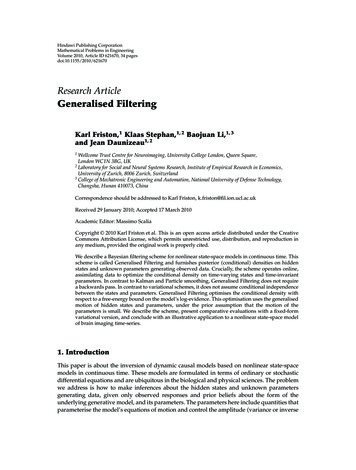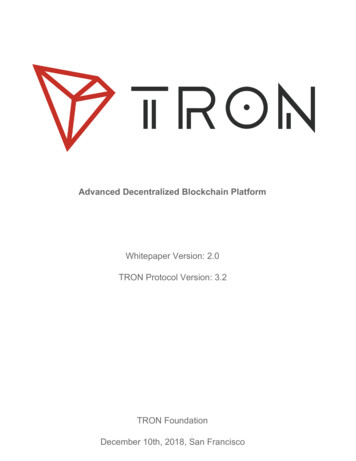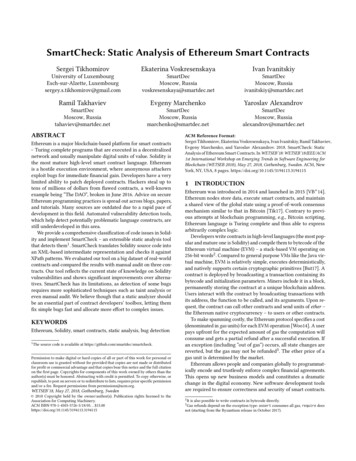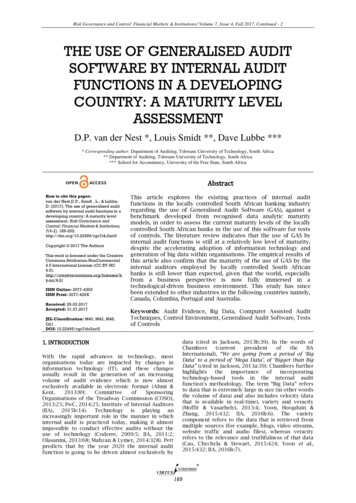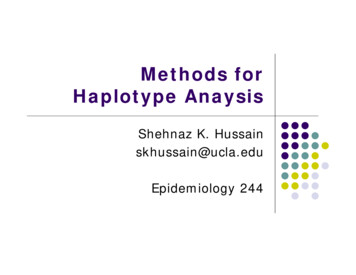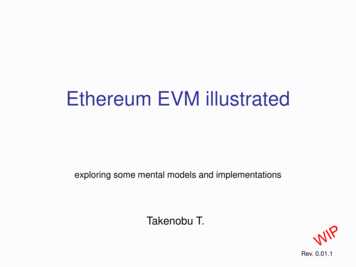
Transcription
ETHEREUM: A SECURE DECENTRALISED GENERALISED TRANSACTION LEDGERBERLIN VERSION 8fea825 – 2022-08-22DR. GAVIN WOODFOUNDER, ETHEREUM & PARITYGAVIN@PARITY.IOAbstract. The blockchain paradigm when coupled with cryptographically-secured transactions has demonstrated itsutility through a number of projects, with Bitcoin being one of the most notable ones. Each such project can be seen asa simple application on a decentralised, but singleton, compute resource. We can call this paradigm a transactionalsingleton machine with shared-state.Ethereum implements this paradigm in a generalised manner. Furthermore it provides a plurality of such resources,each with a distinct state and operating code but able to interact through a message-passing framework with others.We discuss its design, implementation issues, the opportunities it provides and the future hurdles we envisage.1. Introductionis often lacking, and plain old prejudices are difficult toshake.Overall, we wish to provide a system such that userscan be guaranteed that no matter with which other individuals, systems or organisations they interact, they cando so with absolute confidence in the possible outcomesand how those outcomes might come about.With ubiquitous internet connections in most placesof the world, global information transmission has becomeincredibly cheap. Technology-rooted movements like Bitcoin have demonstrated through the power of the default,consensus mechanisms, and voluntary respect of the socialcontract, that it is possible to use the internet to makea decentralised value-transfer system that can be sharedacross the world and virtually free to use. This system canbe said to be a very specialised version of a cryptographically secure, transaction-based state machine. Follow-upsystems such as Namecoin adapted this original “currencyapplication” of the technology into other applications albeitrather simplistic ones.Ethereum is a project which attempts to build the generalised technology; technology on which all transactionbased state machine concepts may be built. Moreover itaims to provide to the end-developer a tightly integratedend-to-end system for building software on a hitherto unexplored compute paradigm in the mainstream: a trustfulobject messaging compute framework.1.2. Previous Work. Buterin [2013a] first proposed thekernel of this work in late November, 2013. Though nowevolved in many ways, the key functionality of a blockchain with a Turing-complete language and an effectivelyunlimited inter-transaction storage capability remains unchanged.Dwork and Naor [1992] provided the first work into theusage of a cryptographic proof of computational expenditure (“proof-of-work”) as a means of transmitting a valuesignal over the Internet. The value-signal was utilised hereas a spam deterrence mechanism rather than any kindof currency, but critically demonstrated the potential fora basic data channel to carry a strong economic signal,allowing a receiver to make a physical assertion withouthaving to rely upon trust. Back [2002] later produced asystem in a similar vein.The first example of utilising the proof-of-work as astrong economic signal to secure a currency was by Vishnumurthy et al. [2003]. In this instance, the token wasused to keep peer-to-peer file trading in check, providing“consumers” with the ability to make micro-payments to“suppliers” for their services. The security model affordedby the proof-of-work was augmented with digital signaturesand a ledger in order to ensure that the historical recordcouldn’t be corrupted and that malicious actors could notspoof payment or unjustly complain about service delivery. Five years later, Nakamoto [2008] introduced anothersuch proof-of-work-secured value token, somewhat wider inscope. The fruits of this project, Bitcoin, became the firstwidely adopted global decentralised transaction ledger.Other projects built on Bitcoin’s success; the alt-coinsintroduced numerous other currencies through alterationto the protocol. Some of the best known are Litecoin andPrimecoin, discussed by Sprankel [2013]. Other projectssought to take the core value content mechanism of the protocol and repurpose it; Aron [2012] discusses, for example,1.1. Driving Factors. There are many goals of thisproject; one key goal is to facilitate transactions betweenconsenting individuals who would otherwise have no meansto trust one another. This may be due to geographicalseparation, interfacing difficulty, or perhaps the incompatibility, incompetence, unwillingness, expense, uncertainty,inconvenience, or corruption of existing legal systems. Byspecifying a state-change system through a rich and unambiguous language, and furthermore architecting a systemsuch that we can reasonably expect that an agreement willbe thus enforced autonomously, we can provide a meansto this end.Dealings in this proposed system would have severalattributes not often found in the real world. The incorruptibility of judgement, often difficult to find, comes naturallyfrom a disinterested algorithmic interpreter. Transparency,or being able to see exactly how a state or judgement cameabout through the transaction log and rules or instructionalcodes, never happens perfectly in human-based systemssince natural language is necessarily vague, information1
ETHEREUM: A SECURE DECENTRALISED GENERALISED TRANSACTION LEDGERthe Namecoin project which aims to provide a decentralisedname-resolution system.Other projects still aim to build upon the Bitcoin network itself, leveraging the large amount of value placed inthe system and the vast amount of computation that goesinto the consensus mechanism. The Mastercoin project,first proposed by Willett [2013], aims to build a richerprotocol involving many additional high-level features ontop of the Bitcoin protocol through utilisation of a numberof auxiliary parts to the core protocol. The Coloured Coinsproject, proposed by Rosenfeld et al. [2012], takes a similarbut more simplified strategy, embellishing the rules of atransaction in order to break the fungibility of Bitcoin’sbase currency and allow the creation and tracking of tokensthrough a special “chroma-wallet”-protocol-aware piece ofsoftware.Additional work has been done in the area with discarding the decentralisation foundation; Ripple, discussed byBoutellier and Heinzen [2014], has sought to create a “federated” system for currency exchange, effectively creatinga new financial clearing system. It has demonstrated thathigh efficiency gains can be made if the decentralisationpremise is discarded.Early work on smart contracts has been done by Szabo[1997] and Miller [1997]. Around the 1990s it became clearthat algorithmic enforcement of agreements could become asignificant force in human cooperation. Though no specificsystem was proposed to implement such a system, it wasproposed that the future of law would be heavily affectedby such systems. In this light, Ethereum may be seen as ageneral implementation of such a crypto-law system.For a list of terms used in this paper, refer to Appendix A.BERLIN VERSIONitself—that would be far too big). They also punctuate thetransaction series with incentives for nodes to mine. Thisincentivisation takes place as a state-transition function,adding value to a nominated account.Mining is the process of dedicating effort (working) tobolster one series of transactions (a block) over any otherpotential competitor block. It is achieved thanks to acryptographically secure proof. This scheme is known as aproof-of-work and is discussed in detail in section 11.5.Formally, we expand to:(2)σ t 1 Π(σ t , B)(3)B (., (T0 , T1 , .), .)(4)Π(σ, B) Ω(B, Υ(Υ(σ, T0 ), T1 ).)Where Ω is the block-finalisation state transition function (a function that rewards a nominated party); B is thisblock, which includes a series of transactions amongst someother components; and Π is the block-level state-transitionfunction.This is the basis of the blockchain paradigm, a modelthat forms the backbone of not only Ethereum, but alldecentralised consensus-based transaction systems to date.2.1. Value. In order to incentivise computation within thenetwork, there needs to be an agreed method for transmitting value. To address this issue, Ethereum has an intrinsiccurrency, Ether, known also as ETH and sometimes referredto by the Old English D̄. The smallest subdenominationof Ether, and thus the one in which all integer values ofthe currency are counted, is the Wei. One Ether is definedas being 1018 Wei. There exist other subdenominations ofEther:Multiplier02. The Blockchain ParadigmEthereum, taken as a whole, can be viewed as atransaction-based state machine: we begin with a genesis state and incrementally execute transactions to morphit into some current state. It is this current state which weaccept as the canonical “version” of the world of Ethereum.The state can include such information as account balances, reputations, trust arrangements, data pertainingto information of the physical world; in short, anythingthat can currently be represented by a computer is admissible. Transactions thus represent a valid arc between twostates; the ‘valid’ part is important—there exist far moreinvalid state changes than valid state changes. Invalid statechanges might, e.g., be things such as reducing an accountbalance without an equal and opposite increase elsewhere.A valid state transition is one which comes about througha transaction. Formally:(1)σ t 1 Υ(σ t , T )where Υ is the Ethereum state transition function. InEthereum, Υ, together with σ are considerably more powerful than any existing comparable system; Υ allows components to carry out arbitrary computation, while σ allowscomponents to store arbitrary state between transactions.Transactions are collated into blocks; blocks are chainedtogether using a cryptographic hash as a means of reference. Blocks function as a journal, recording a series oftransactions together with the previous block and an identifier for the final state (though do not store the final out the present work, any reference to value,in the context of Ether, currency, a balance or a payment,should be assumed to be counted in Wei.2.2. Which History? Since the system is decentralisedand all parties have an opportunity to create a new blockon some older pre-existing block, the resultant structure isnecessarily a tree of blocks. In order to form a consensusas to which path, from root (the genesis block) to leaf (theblock containing the most recent transactions) throughthis tree structure, known as the blockchain, there mustbe an agreed-upon scheme. If there is ever a disagreementbetween nodes as to which root-to-leaf path down the blocktree is the ‘best’ blockchain, then a fork occurs.This would mean that past a given point in time (block),multiple states of the system may coexist: some nodes believing one block to contain the canonical transactions,other nodes believing some other block to be canonical,potentially containing radically different or incompatibletransactions. This is to be avoided at all costs as the uncertainty that would ensue would likely kill all confidencein the entire system.The scheme we use in order to generate consensus is asimplified version of the GHOST protocol introduced bySompolinsky and Zohar [2013]. This process is describedin detail in section 10.
ETHEREUM: A SECURE DECENTRALISED GENERALISED TRANSACTION LEDGERSometimes, a path follows a new protocol from a particular height (block number). This document describesone version of the protocol, namely the Berlin versiondefined by Beiko et al. [2021b]. In order to follow back thehistory of a path, one must reference multiple versions ofthis document. Here are the block numbers of protocolupdates on the Ethereum main network:NameFirst Block 12244000129650001377300015050000Occasionally actors do not agree on a protocol change,and a permanent fork occurs. In order to distinguish between diverged blockchains, EIP-155 by Buterin [2016b]introduced the concept of chain ID, which we denote by β.For the Ethereum main network(5)β 13. ConventionsWe use a number of typographical conventions for theformal notation, some of which are quite particular to thepresent work:The two sets of highly structured, ‘top-level’, state values, are denoted with bold lowercase Greek letters. Theyfall into those of world-state, which are denoted σ (or avariant thereupon) and those of machine-state, µ.Functions operating on highly structured values aredenoted with an upper-case Greek letter, e.g. Υ, theEthereum state transition function.For most functions, an uppercase letter is used, e.g. C,the general cost function. These may be subscripted todenote specialised variants, e.g. CSSTORE , the cost function for the SSTORE operation. For specialised and possiblyexternally defined functions, we may format as typewritertext, e.g. the Keccak-256 hash function (as per version3 of the winning entry to the SHA-3 contest by Bertoniet al. [2011], rather than the final SHA-3 specification), isdenoted KEC (and generally referred to as plain Keccak).Also, KEC512 refers to the Keccak-512 hash function.Tuples are typically denoted with an upper-case letter,e.g. T , is used to denote an Ethereum transaction. Thissymbol may, if accordingly defined, be subscripted to referto an individual component, e.g. Tn , denotes the nonceof said transaction. The form of the subscript is used todenote its type; e.g. uppercase subscripts refer to tupleswith subscriptable components.Scalars and fixed-size byte sequences (or, synonymously,arrays) are denoted with a normal lower-case letter, e.g.n is used in the document to denote a transaction nonce.Those with a particularly special meaning may be Greek,e.g. δ, the number of items required on the stack for agiven operation.BERLIN VERSION3Arbitrary-length sequences are typically denoted as abold lower-case letter, e.g. o is used to denote the bytesequence given as the output data of a message call. Forparticularly important values, a bold uppercase letter maybe used.Throughout, we assume scalars are non-negative integers and thus belong to the set N. The set of all bytesequences is B, formally defined in Appendix B. If sucha set of sequences is restricted to those of a particularlength, it is denoted with a subscript, thus the set of allbyte sequences of length 32 is named B32 and the set ofall non-negative integers smaller than 2256 is named N256 .This is formally defined in section 4.3.Square brackets are used to index into and referenceindividual components or subsequences of sequences, e.g.µs [0] denotes the first item on the machine’s stack. Forsubsequences, ellipses are used to specify the intendedrange, to include elements at both limits, e.g. µm [0.31]denotes the first 32 items of the machine’s memory.In the case of the global state σ, which is a sequence ofaccounts, themselves tuples, the square brackets are usedto reference an individual account.When considering variants of existing values, we followthe rule that within a given scope for definition, if weassume that the unmodified ‘input’ value be denoted bythe placeholder then the modified and utilisable value isdenoted as 0 , and intermediate values would be , &c. On very particular occasions, in order to maximisereadability and only if unambiguous in meaning, we mayuse alpha-numeric subscripts to denote intermediate values,especially those of particular note.When considering the use of existing functions, given afunction f , the function f denotes a similar, element-wiseversion of the function mapping instead between sequences.It is formally defined in section 4.3.We define a number of useful functions throughout. Oneof the more common is , which evaluates to the last itemin the given sequence:(6) (x) x[kxk 1]4. Blocks, State and TransactionsHaving introduced the basic concepts behind Ethereum,we will discuss the meaning of a transaction, a block andthe state in more detail.4.1. World State. The world state (state), is a mapping between addresses (160-bit identifiers) and accountstates (a data structure serialised as RLP, see Appendix B).Though not stored on the blockchain, it is assumed thatthe implementation will maintain this mapping in a modified Merkle Patricia tree (trie, see Appendix D). The trierequires a simple database backend that maintains a mapping of byte arrays to byte arrays; we name this underlyingdatabase the state database. This has a number of benefits;firstly the root node of this structure is cryptographicallydependent on all internal data and as such its hash canbe used as a secure identity for the entire system state.Secondly, being an immutable data structure, it allows anyprevious state (whose root hash is known) to be recalledby simply altering the root hash accordingly. Since westore all such root hashes in the blockchain, we are able totrivially revert to old states.
ETHEREUM: A SECURE DECENTRALISED GENERALISED TRANSACTION LEDGERThe account state, σ[a], comprises the following fourfields:nonce: A scalar value equal to the number of transactions sent from this address or, in the caseof accounts with associated code, the number ofcontract-creations made by this account. For account of address a in state σ, this would be formally denoted σ[a]n .balance: A scalar value equal to the number of Weiowned by this address. Formally denoted σ[a]b .storageRoot: A 256-bit hash of the root node of aMerkle Patricia tree that encodes the storage contents of the account (a mapping between 256-bitinteger values), encoded into the trie as a mappingfrom the Keccak 256-bit hash of the 256-bit integerkeys to the RLP-encoded 256-bit integer values.The hash is formally denoted σ[a]s .codeHash: The hash of the EVM code of thisaccount—this is the code that gets executed shouldthis address receive a message call. All suchcode fragments are contained in the state database under their corresponding hashes for laterretrieval. This hash is formally denoted σ[a]c , andthus the code may be denoted as b, given thatKEC(b) σ[a]c .Since we typically wish to refer not to the trie’s roothash but to the underlying set of key/value pairs storedwithin, we define a convenient equivalence: (7)TRIE L I (σ[a]s ) σ[a]sThe collapse function for the set of key/value pairs inthe trie, L I , is defined as the element-wise transformationof the base function LI , given as: (8)LI (k, v) KEC(k), RLP(v)where:(9)k B32 v NIt shall be understood that σ[a]s is not a ‘physical’member of the account and does not contribute to its laterserialisation.If the codeHash field is the Keccak-256 hash of theempty string, i.e. σ[a]c KEC () , then the node representsa simple account, sometimes referred to as a “non-contract”account.Thus we may define a world-state collapse function LS :(10)LS (σ) {p(a) : σ[a] 6 }where(11)p(a) KEC(a), RLP (σ[a]n , σ[a]b , σ[a]s , σ[a]c ) This function, LS , is used alongside the trie functionto provide a short identity (hash) of the world state. Weassume:(12) a : σ[a] (a B20 v(σ[a]))where v is the account validity function:(13)v(x) xn N256 xb N256 xs B32 xc B32BERLIN VERSION4An account is empty when it has no code, zero nonceand zero balance:(14) EMPTY(σ, a) σ[a]c KEC () σ[a]n 0 σ[a]b 0Even callable precompiled contracts can have an emptyaccount state. This is because their account states do notusually contain the code describing its behavior.An account is dead when its account state is non-existentor empty:(15)DEAD(σ, a) σ[a] EMPTY(σ, a)4.2. The Transaction. A transaction (formally, T ) is asingle cryptographically-signed instruction constructed byan actor externally to the scope of Ethereum. The senderof a transaction cannot be a contract. While it is assumedthat the ultimate external actor will be human in nature,software tools will be used in its construction and dissemination1. EIP-2718 by Zoltu [2020] introduced the notionof different transaction types. As of the Berlin version ofthe protocol, there are two transaction types: 0 (legacy)and 1 (EIP-2930 by Buterin and Swende [2020b]). Further,there are two subtypes of transactions: those which resultin message calls and those which result in the creation ofnew accounts with associated code (known informally as‘contract creation’). All transaction types specify a numberof common fields:type: EIP-2718 transaction type; formally Tx .nonce: A scalar value equal to the number of transactions sent by the sender; formally Tn .gasPrice: A scalar value equal to the number ofWei to be paid per unit of gas for all computationcosts incurred as a result of the execution of thistransaction; formally Tp .gasLimit: A scalar value equal to the maximumamount of gas that should be used in executingthis transaction. This is paid up-front, before anycomputation is done and may not be increasedlater; formally Tg .to: The 160-bit address of the message call’s recipient or, for a contract creation transaction, , usedhere to denote the only member of B0 ; formallyTt .value: A scalar value equal to the number of Wei tobe transferred to the message call’s recipient or,in the case of contract creation, as an endowmentto the newly created account; formally Tv .r, s: Values corresponding to the signature of thetransaction and used to determine the sender ofthe transaction; formally Tr and Ts . This is expanded in Appendix F.EIP-2930 (type 1) transactions also have:accessList: List of access entries to warm up; formally TA . Each access list entry E is a tupleof an account address and a list of storage keys:E (Ea , Es ).chainId: Chain ID; formally Tc . Must be equal tothe network chain ID β.yParity: Signature Y parity; formally Ty .1Notably, such ‘tools’ could ultimately become so causally removed from their human-based initiation—or humans may become socausally-neutral—that there could be a point at which they rightly be considered autonomous agents. e.g. contracts may offer bounties tohumans for being sent transactions to initiate their execution.
ETHEREUM: A SECURE DECENTRALISED GENERALISED TRANSACTION LEDGERLegacy transactions do not have an accessList (TA ()), while chainId and yParity for legacy transactionsare combined into a single value:w: A scalar value encoding Y parity and possibly chain ID; formally Tw . Tw 27 Ty orTw 2β 35 Ty (see EIP-155 by Buterin [2016b]).Additionally, a contract creation transaction (regardlesswhether legacy or EIP-2930) contains:init: An unlimited size byte array specifying theEVM-code for the account initialisation procedure,formally Ti .init is an EVM-code fragment; it returns the body,a second fragment of code that executes each time theaccount receives a message call (either through a transaction or due to the internal execution of code). init isexecuted only once at account creation and gets discardedimmediately thereafter.In contrast, a message call transaction contains:data: An unlimited size byte array specifying theinput data of the message call, formally Td .Appendix F specifies the function, S, which maps transactions to the sender, and happens through the ECDSA ofthe SECP-256k1 curve, using the hash of the transaction(excepting the latter three signature fields) as the datumto sign. For the present we simply assert that the senderof a given transaction T can be represented with S(T ).LT (T ) (Tn , Tp , Tg , Tt , Tv , p, Tw , Tr , Ts )(Tc , Tn , Tp , Tg , Tt , Tv , p, TA , Ty , Tr , Ts )if Tx 0if Tx 1where(p (17)TiTdif Tt otherwiseHere, we assume all components are interpreted by theRLP as integer values, with the exception of the access listTA and the arbitrary length byte arrays Ti and Td .(18)Tx {0, 1}Tp N256Tw N256Ty N1 Tc βTg N256Tr N256Td B Tn N256Tv N256Ts N256Ti B where(19)Nn {P : P N P 2n }The address hash Tt is slightly different: it is either a20-byte address hash or, in the case of being a contractcreation transaction (and thus formally equal to ), it isthe RLP empty byte sequence and thus the member of B0 :(B20 if Tt 6 (20)Tt B0 otherwise4.3. The Block. The block in Ethereum is the collection of relevant pieces of information (known as the blockheader ), H, together with information corresponding tothe comprised transactions, T, and a set of other blockheaders U that are known to have a parent equal to thepresent block’s parent’s parent (such blocks are known asommers 2). The block header contains several pieces ofinformation:5parentHash: The Keccak 256-bit hash of the parentblock’s header, in its entirety; formally Hp .ommersHash: The Keccak 256-bit hash of the ommers list portion of this block; formally Ho .beneficiary: The 160-bit address to which all feescollected from the successful mining of this blockbe transferred; formally Hc .stateRoot: The Keccak 256-bit hash of the rootnode of the state trie, after all transactions areexecuted and finalisations applied; formally Hr .transactionsRoot: The Keccak 256-bit hash of theroot node of the trie structure populated with eachtransaction in the transactions list portion of theblock; formally Ht .receiptsRoot: The Keccak 256-bit hash of the rootnode of the trie structure populated with the receipts of each transaction in the transactions listportion of the block; formally He .logsBloom: The Bloom filter composed from indexable information (logger address and log topics)contained in each log entry from the receipt ofeach transaction in the transactions list; formallyHb .difficulty: A scalar value corresponding to the difficulty level of this block. This can be calculatedfrom the previous block’s difficulty level and thetimestamp; formally Hd .number: A scalar value equal to the number of ancestor blocks. The genesis block has a number ofzero; formally Hi .gasLimit: A scalar value equal to the current limitof gas expenditure per block; formally Hl .gasUsed: A scalar value equal to the total gas usedin transactions in this block; formally Hg .timestamp: A scalar value equal to the reasonableoutput of Unix’s time() at this block’s inception;formally Hs .extraData: An arbitrary byte array containing datarelevant to this block. This must be 32 bytes orfewer; formally Hx .mixHash: A 256-bit hash which, combined with thenonce, proves that a sufficient amount of computation has been carried out on this block; formallyHm .nonce: A 64-bit value which, combined with the mixhash, proves that a sufficient amount of computation has been carried out on this block; formallyHn .(16)(BERLIN VERSIONThe other two components in the block are simply a listof ommer block headers (of the same format as above),BU and a series of the transactions, BT . Formally, we canrefer to a block B:(21)B (BH , BT , BU )2ommer is a gender-neutral term to mean “sibling of parent”; see https://nonbinary.miraheze.org/wiki/Gender neutral language inEnglish#Aunt/Uncle
ETHEREUM: A SECURE DECENTRALISED GENERALISED TRANSACTION LEDGER4.3.1. Transaction Receipt. In order to encode informationabout a transaction concerning which it may be usefulto form a zero-knowledge proof, or index and search, weencode a receipt of each transaction containing certain information from its execution. Each receipt, denoted BR [i]for the ith transaction, is placed in an index-keyed trieand the root recorded in the header as He .The transaction receipt, R, is a tuple of five items comprising: the type of the transaction, Rx , the status code ofthe transaction, Rz , the cumulative gas used in the blockcontaining the transaction receipt as of immediately afterthe transaction has happened, Ru , the set of logs createdthrough execution of the transaction, Rl and the Bloomfilter composed from information in those logs, Rb :4.3.2. Holistic Validity. We can assert a block’s validityif and only if it satisfies several conditions: it must be internally consistent with the ommer and transaction blockhashes and the given transactions BT (as specified in sec11), when executed in order on the base state σ (derivedfrom the final state of the parent block), result in a newstate of the identity Hr :(33)HrHoHt He Hb R (Rx , Rz , Ru , Rb , Rl )(22)Rx is equal to the type of the corresponding transaction.The function LR prepares a transaction receipt for beingtransformed into an RLP-serialised byte array:LR (R) (Rz , Ru , Rb , Rl )(23)We assert that the status code Rz is a non-negativeinteger:pR (k, R) Ru N O (Oa , (Ot0 , Ot1 , .), Od )Oa B20 RLP(LR (R))RLP(k),(Rx ) · RLP(LR (R))if Rx 0otherwise!(· is the concatenation of byte arrays).Furthermore:(36)(27) Rb B256The sequence Rl is a series of log entries, (O0 , O1 , .).A log entry, O, is a tuple of the logger’s address, Oa , apossibly empty series of 32-byte log topics, Ot and somenumber of bytes of data, Od :(26) and(35)(We assert that Ru , the cumulative gas used, is a nonnegative integer and that the logs Bloom, Rb , is a hash ofsize 2048 bits (256 bytes):(25)TRIE(LS (Π(σ, B)))KEC(RLP(L H (BU )))TRIE({ i kBT k, i N :pT (i, BT [i])})TRIE({ i kBR k, i N :W pR (i, B R [i])})r BR rbwhere pT (k, v) and pR (k, v) are pairwise RLP transformations, but with a special treatment for EIP-2718 transactions:(34)(!RLP(LT (T ))if Tx 0pT (k, T ) RLP(k),(Tx ) · RLP(LT (T )) otherwiseRz N(24)6BERLIN VERSION x Ot : x B32 Od BWe define the Bloom filter function, M , to reduce a logentry into a single 256-byte hash: (28)M (O) x {Oa } Ot M3:2048 (x)where M3:2048 is a specialised Bloom filter that sets threebits out of 2048, given an arbitrary byte sequence. It doesthis through taking the low-order 11 bits of each of thefirst three pairs of bytes in a Keccak-256 hash of the bytesequence.3 Formally:(29)M3:2048 (x : x B) y : y B
ethereum: a secure decentralised generalised transaction ledger berlin version 8fea825 { 2022-08-22 dr. gavin wood founder, ethereum & parity gavin@parity.io
